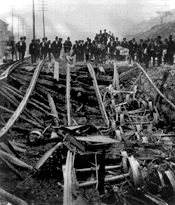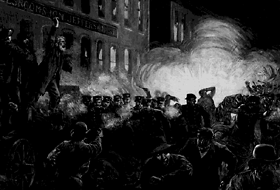Carnivals of RevengeThe frustrations of Gilded Age workers transformed the labor movement into a vigorous, if often violent, force. Workers saw men like Andrew Carnegie getting fabulously rich, and raged at being left behind. With their own labor the only available bargaining chip, workers frequently went on strike. The 1880's witnessed almost ten thousand strikes and lockouts; close to 700,000 workers struck in 1886 alone.
|
|
| The results were often explosive-none more than the Great Railroad Strike
of 1877. When the B&O Railroad cut wages, workers staged spontaneous
strikes, which spread nationwide. In Baltimore, the state militia fired on
strikers, leaving 11 dead and 40 wounded. In Pittsburgh, Andrew Carnegie's
mentor, Thomas Scott of the Pennsylvania Railroad, urged that strikers be
given "a rifle diet for a few days and see how they like that kind of bread."
In Philadelphia, strikers battled local militia, burning much of the downtown
area before the federal troops intervened. The wage reductions remained in
place, and the War Department created the national guard to put down future
disturbances.
Industrialists took a harder line against unions, but the labor movement grew. In 1877, three national unions existed; in 1880 there were eighteen. For many Americans, unionization fed a fear that "barbarians" had invaded the nation. During a Cleveland steel strike, violent confrontations led local newspapers to attack the "un-American" Polish workers as "Ignorant and degraded whelps," "Foreign devils," and "Communistic scoundrels [who] revel in robberies, bloodshed, and arson."
In 1886, a national strike called for changing the standard workday from 12-hours to eight. At 12,000 companies nationwide, 340,000 workers stopped work. In Chicago police were trying to break up a large labor meeting in Haymarket Square, when a bomb exploded without warning, killing a police officer. Police fired into the crowd, killing one and wounding many more. As a result of the riot, four labor organizers were hanged. The hangings demoralized the national labor movement and energized management. By 1890, Knights of Labor membership had plummeted by ninety percent. The 1892 battle at Carnegie's Homestead mill became a model for stamping out strikes: hold firm and call in government troops for support.
|
|
 |
The brutal depression of 1893-94 triggered some of the worst labor conflicts
in the country's history, including the strike against the Pullman Palace
Car Company. When George Pullman slashed wages and hiked rents in his company
town, a national strike and boycott was called on all railways carrying Pullman
cars. Railroad traffic ground to a halt as 260,000 workers struck, and battles
with state and federal troops broke out in 26 states. The strike ultimately
failed, its leaders imprisoned and many strikers blacklisted.
The labor movement lay in shambles, and would not rise again for nearly fifty years. Although workers would find new strength in the next century, they would never again pose the same broad challenge to the claims of capital. |
|
Originalseite unter http://www.pbs.org/wgbh/amex/carnegie/index.html |
|
